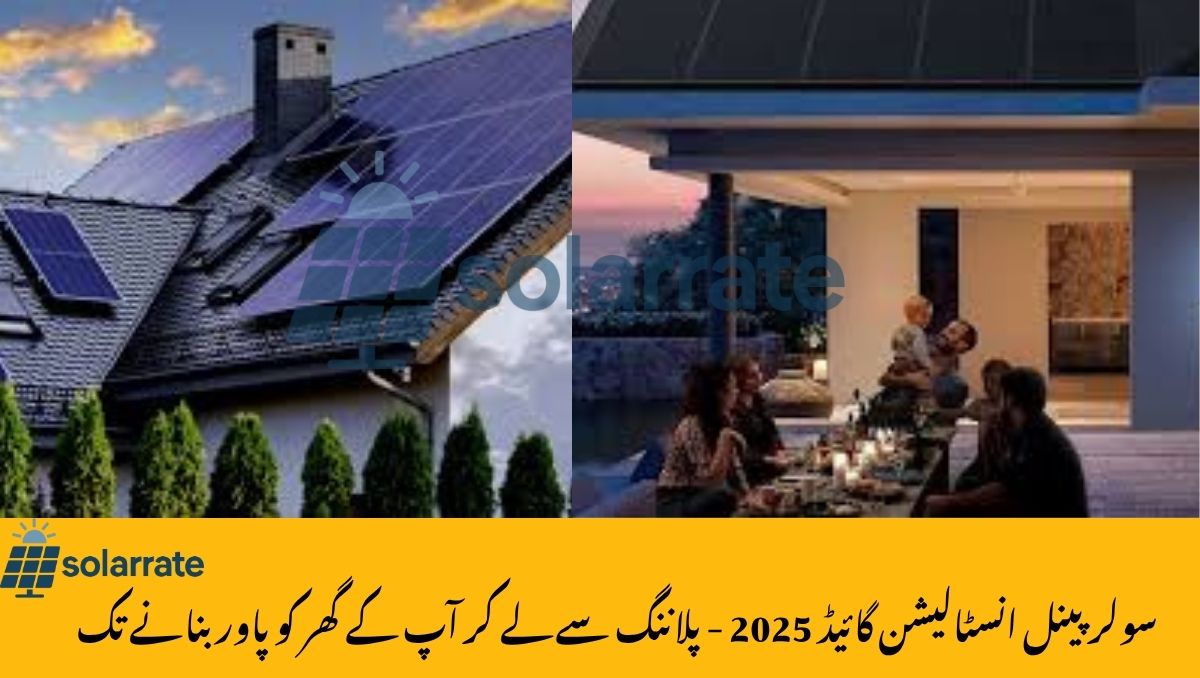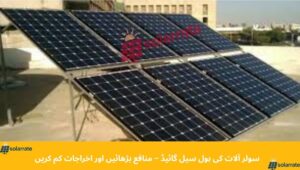Solar Panel Installation Guide 2025 explains that electricity rates in Pakistan are continuously increasing, and load shedding has become a common problem. Because of this, many people now consider solar energy as a better and cheaper solution. By installing a solar system once, you can enjoy free electricity for a long time and become less dependent on WAPDA. If you also want your home to be free from electricity problems and reduce your monthly electricity bill, this Solar Panel Installation Guide 2025 will provide you with complete, easy-to-understand guidance at every step of installing a solar system.
Visit Now:https://cmsolarscheme.punjab.gov.pk/

Planning Phase
⚡ Estimate Your Electricity Needs
First of all, it is important to know how much electricity you need daily and monthly. Look at your previous electricity bills to find out.
📊 Example:
If your monthly bill is around 300 units, it means you may need a 3 to 5 kW solar system.
(Unit = Kilowatt hour)
🏠 Examine Your Roof
The location and direction of the roof are very important for installing solar panels:
☀️ The best roof is one that faces south because it receives the most sunlight.
🌳 There should be no shade, i.e., no trees, tanks, or walls that can block the sunlight from reaching the panels.
📐 Space calculation:
For every 1 kW system, approximately 100 square feet of space is required.
So, if you want a 5 kW system, your roof should have at least 500 square feet of open space.
This is an important part of the Solar Panel Installation Guide 2025 to help you plan the right system size and placement for your home.
Also Read:Complete Guide to Solar Panel Prices and Installation in Pakistan 2025
System selection
⚖️ Which System Is Better: On-Grid, Off-Grid, or Hybrid?
When you decide to install a solar system, it’s important to choose the right type for your needs. Here’s a quick comparison:
☀️ The On-Grid System is connected directly to WAPDA. If you generate more electricity than you use, the extra power is fed back to the grid (WAPDA). This system supports net metering, allowing you to effectively “sell” electricity to the grid. However, it requires a continuous electricity supply; if the power goes out, the system shuts down.
🔋 The Off-Grid System is fully battery dependent and is not connected to the grid. It is ideal for areas with frequent load shedding or where WAPDA connection is unavailable. This system is more expensive due to battery costs but provides power even during outages because of stored energy.
🔄 The Hybrid System combines features of both on-grid and off-grid systems. It allows you to use battery-stored electricity and net metering simultaneously. Although more costly, it offers the best and most sustainable solution in the long run.
This comparison is an important part of the Solar Panel Installation Guide 2025 to help you select the best system for your home.
Choosing a reliable company
There are many companies in the market providing solar systems, but not every company is reliable. Before installing your system, always make sure that the company is:
🔒 Registered with NEPRA (National Electric Power Regulatory Authority) and AEDB (Alternative Energy Development Board). Installing through a registered company ensures legal net metering and a safe installation.
What to Check Before Choosing a Company
🕰️ Experience:
How many years has the company been operating? Have they completed both small and large projects successfully?
🌐 Customer Reviews:
Check online platforms like social media and Google to see what customers say. Are people satisfied with the company’s services?
🛡️ Warranty:
Does the company offer a warranty on panels, inverters, and installation? Ideally, there should be at least a 5 to 10-year warranty for peace of mind.
🔧 After-Sales Service:
Is the company willing to provide support and address complaints after installation? Good companies offer full support even after the system is up and running.
📑 Net Metering Facility:
The company should assist you in submitting the net metering application and guide you through the entire approval process.
Choosing the right company is a key step emphasized in the Solar Panel Installation Guide 2025 to ensure your investment is safe and efficient.
Net metering request
If you want to avail the benefits of net metering, you need to submit some important documents:
🆔 CNIC:
The solar system should be registered in the name of the owner.
📜 Latest Electricity Bill:
It must show the same meter number where the solar system is being installed.
📊 System Design Report:
This report is provided by the installer and contains detailed information about the system and its safety standards.
🔖 Installer’s License Number:
The company or individual installing your system must be approved by AEDB (Alternative Energy Development Board).
Submitting these documents correctly is a crucial step outlined in the Solar Panel Installation Guide 2025 to ensure smooth net metering approval.
Also Read:CM Punjab Solar Energy Initiative 2025 – Light Up Your Home Without Bills
Installation process
The solar panels are mounted on a sturdy frame fixed securely on your roof. Care is taken to position them at the right angle to receive maximum sunlight throughout the day.
⚡ Inverter Setup:
The inverter is installed on a wall and connected to the solar panels. Its job is to convert the DC electricity generated by the panels into AC electricity, which powers your home appliances.
🔋 Battery System (if applicable):
If you have chosen a hybrid or off-grid system, batteries are also installed to store electricity. These batteries should be placed in a cool and well-ventilated area to ensure safety and efficiency.
🧪 System Testing:
Once installation is complete, the entire system undergoes thorough testing. Voltage, connections, and overall performance are checked to ensure everything is working perfectly.
👨🏫 User Training:
You will be guided on how to operate the system, monitor inverter data, check battery levels, and understand what steps to take if any issues arise.
After this phase, your home will be fully ready to generate reliable electricity from solar energy.
This step-by-step process is a core part of the Solar Panel Installation Guide 2025 to ensure a safe and efficient solar setup.
Maintenance and performance
To increase your electricity generation, follow this simple monthly checklist:
🧼 Cleaning the Panels (every 15 days):
Dust, dirt, or bird droppings can accumulate on the panels and reduce their efficiency. Clean the panels in the morning or evening using clean water and a soft cloth.
🔌 Check the Wiring:
Inspect the wiring every month for any loose or burnt wires. If you find any issues, have them fixed immediately by a qualified electrician.
📟 Check the Inverter Screen:
The inverter’s display shows how much electricity your system is generating. If you notice any error or warning messages, contact your installer immediately.
💡 Tips to Improve Performance:
🌞 Protect the panels from shade, leaves, or bird droppings so they receive full sunlight.
🛠️ Get your system fully serviced by a specialist every 6 months for optimal performance.
🌧️ If it rains, cleaning can be postponed for a few days, but otherwise, regular cleaning is necessary.
Following this maintenance routine is an essential part of the Solar Panel Installation Guide 2025 to keep your system running efficiently.
| Phase | Details |
|---|---|
| Planning Phase | Estimate electricity needs (e.g., 300 units ≈ 3-5 kW system). Examine roof (south-facing, shade-free, space required: 100 sq ft/kW). |
| System Selection | On-grid (connected to WAPDA, net metering, needs power), Off-grid (battery-based, costly, for load shedding areas), Hybrid (both systems combined, costly but sustainable). |
| Choosing Company | Choose NEPRA & AEDB registered companies. Check experience, customer reviews, warranty (5-10 years), after-sales service, and net metering support. |
| Net Metering Documents | CNIC in owner’s name, latest electricity bill with correct meter number, system design report, installer’s AEDB license. |
| Installation Process | Mount panels on sturdy frame at proper angle, install inverter (DC to AC), install batteries if hybrid/off-grid, test system, provide user training. |
| Maintenance & Performance | Clean panels every 15 days, check wiring monthly, monitor inverter display, protect panels from shade/dirt, service every 6 months, postpone cleaning during rain. |
Also Read:How Many Air Conditioners Can a 3 kW Solar System Run at Home? Complete Guide
Conclusion
Solar Panel Installation Guide 2025 shows that solar energy is a great and wise investment for your home in 2025. It will not only reduce your monthly electricity bills but also help you get rid of load shedding to a large extent. By using eco-friendly energy, you also play a positive role for the country and future generations.
If you plan well before installing the system, choose only quality panels, inverters, and batteries, and have the installation done by an experienced and registered installer, then you can generate your own electricity for a long time without any hassle — that too for free!
FAQ’s
What is the Solar Panel Installation Guide 2025?
The Solar Panel Installation Guide 2025 is a complete step-by-step resource to help homeowners install solar panels efficiently and cost-effectively in 2025.
How do I estimate my electricity needs using the Solar Panel Installation Guide 2025?
According to the Solar Panel Installation Guide 2025, you should check your monthly electricity bill (in units) to determine the size of the solar system, typically 3-5 kW for around 300 units.
Which solar system is best according to the Solar Panel Installation Guide 2025: on-grid, off-grid, or hybrid?
The Solar Panel Installation Guide 2025 explains that on-grid systems work well where electricity is stable, off-grid suits areas with frequent load shedding, and hybrid systems combine both for maximum reliability.
How do I choose a reliable company based on the Solar Panel Installation Guide 2025?
The Solar Panel Installation Guide 2025 recommends selecting companies registered with NEPRA and AEDB, with positive customer reviews, solid warranty, and after-sales service.
What documents do I need for net metering as per the Solar Panel Installation Guide 2025?
The Solar Panel Installation Guide 2025 states you need your CNIC, latest electricity bill, system design report, and the installer’s AEDB license number for net metering applications.



